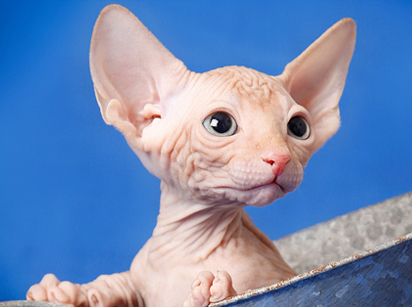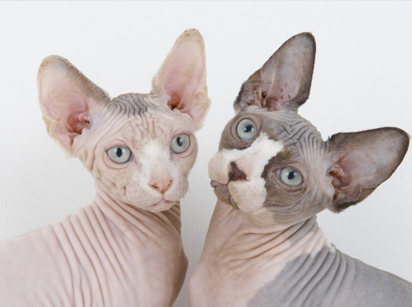Sphynx



PHYSICAL CHARACTERISTICS
This is a medium- to large-sized cat, muscular and heavy for its appearance and size. Its ears are large to very large, open wide and upright, much like the ears of a bat. The eyes are set wide and are round with a slight slant at the upper corners -- lemon shaped, by most accounts. The widely set eyes and wide open roundness of the eyes give the Sphynx an approachable, friendly appearance. There is no specific color expected of the eyes, and can vary. Its cheekbones, meanwhile, are prominent, giving this breed a regalness that brings to mind Egyptian cats of lore.
Whiskers and eyebrows may be in place, or may not be at all. If there are whiskers they are expected to be broken and sparse. The whisker pads are full, as are the pads of the feet. Also full is the belly, often described as a "pot belly." This is an expected characteristic of the cat and should not be discouraged, especially since the Sphynx has a hearty appetite and a very high metabolism. If in doubt, check with your veterinarian.
In body, though they appear to be hairless, not all Sphynxes are hairless. They are actually covered with a fine gossamery down which can only barely be felt or even seen by the naked eye. Because of its fineness, the skin of the Sphynx is often compared to warm suede. Another unusual trait of this cat is its wrinkles. Around the shoulders, between the ears, and around the muzzle is where the wrinkles should be heaviest.
Wrinkles are not relegated solely to the Sphynx, they are present in other cats, too, but it is more apparent in the Sphynx because of its lack of fur. Coloring can vary considerably. The markings of the skin mimic the markings one would find on fur. What makes a Sphynx a Sphynx is mainly the quality of hairlessness, so the standard does not include colors or markings, except to say that all colors and patterns, in any combination that would be found in a feline, is acceptable for the Sphynx.
PERSONALITY AND TEMPERAMENT
This is a high energy cat which can perform acrobatic tricks, much like a monkey. The Sphynx is excellent at balancing, climbing atop doors and bookshelves, and even perching on shoulders like a bird. They love human attention and will perform shenanigans for everyone's entertainment. Like a clown, the Sphynx will caper about and pratfall, it truly enjoys being a show-off. The Sphynx is curious and mischievous, and these qualities, coupled with the high level of intelligence found in this breed, can make it a handful. But, it is also a well behaved and easy to handle breed. Because of its friendliness and sense of humor, along with ease of handling, the Sphynx is a favorite with show judges. It does best as an indoor cat, since these same charming qualities can get it into dangerous situation. It is also loyal and affectionate towards its owners, even following you around the house, wagging its tail. The Sphynx is a true extrovert. It will demand your undivided attention and hates to be ignored. The Sphynx also does well with other animals, both dogs and cats.
CARE
Despite his bald body, a Sphynx requires at least as much grooming as cats with fur and maybe even more. Their skin must be kept moisturized with a gentle, scent-free lotion or oil, and they need weekly baths so as not to leave greasy spots on your furniture and clothing. Use a gentle baby shampoo or moisturizing shampoo and rinse thoroughly, especially between the folds of the wrinkles. If you begin bathing your Sphynx kitten while he is young, he will learn to accept and sometimes even enjoy baths. Baby wipes will help to keep him clean between baths.
Brush the teeth to prevent periodontal disease. Daily dental hygiene is best, but weekly brushing is better than nothing. Wipe the corners of the eyes daily with a soft, damp cloth to remove any discharge. Use a separate area of the cloth for each eye so you don’t run the risk of spreading any infection. Check the ears weekly. If they look dirty, wipe them out with a cotton ball or soft damp cloth moistened with a 50-50 mixture of cider vinegar and warm water. Avoid using cotton swabs, which can damage the interior of the ear.
Keep the litter box spotlessly clean. Like all cats, Sphynx are very particular about bathroom hygiene.
Although the Sphynx feels warm to the touch, he doesn’t have a fur coat to keep him warm. If you’re cold, he probably is too. Buy him a nice sweater or two to help him retain heat.
It’s a good idea to keep a Sphynx as an indoor-only cat to protect him from diseases spread by other cats, attacks by dogs or coyotes, and the other dangers that face cats who go outdoors, such as being hit by a car. Sphynx who go outdoors also run the risk of being stolen by someone who would like to have such an unusual cat without paying for it. If your Sphynx has an outdoor enclosure where he can sunbathe, be sure to apply cat-safe sunscreen to his skin to prevent sunburn.
HEALTH
Both pedigreed cats and mixed-breed cats have varying incidences of health problems that may be genetic in nature. Sphynx are generally healthy, although the following diseases have been seen in the breed:
- Urticaria pigmentosa, a skin disease that causes crusty sores on the body.
- Hypertrophic cardiomyopathy, a form of heart disease that is inherited in some cat breeds such as the Maine Coon. Heritability has not been proven in the Sphynx
HISTORY AND BACKGROUND
The unusual characteristic of a hairless cat was probably a naturally spontaneous mutation in the breed. "The Book of the Cat" published in 1903 refers to a pair of hairless cats called Mexican Hairless, which was obtained from a New Mexican couple from local Pueblo Indians. The breed later resurfaced when a couple of Siamese cats gave birth to three hairless kittens in 1950 in Paris. And although subsequent mating between the same pair produced the same result, breeding with other Siamese cats did not lead to hairless offspring.
Other hairless specimens were discovered in Morocco, Australia, North Carolina, and in Toronto, Canada, where in 1966, a pair of domestic shorthairs produced a litter that included a hairless kitten. It was then that the modern Sphynx came into existence.
However, the familiar history of the Sphynx breed begins in 1975. Minnesota farm owners, Milt and Ethelyn Pearson, found that a hairless kitten had been born to their farm cat, Jezabelle. This kitten, Epidermis, was then paired with a later born hairless kitten named Dermis, and sold to Kim Mueske, an Oregon breeder.
In 1978, Siamese breeder Shirley Smith of Ontario, discovered two hairless kittens on her neighborhood street. The two kittens, Punkie and Paloma, were both acquired by Dr. Hugo Hernandez and bred with a white Devon Rex named Curare van Jetrophin. The cats produced from this union, along with the cats from Oregon, laid the foundation for a new breed line. Although it is not the Sphynx we know today, because pairings of the Sphynx with the Devon Rex resulted in congenital abnormalities, the resultant offspring was enough to cause a ripple of excitement in the cat breeding community.
Breeders in Europe and North America set to work perfecting the breed, outcrossing the Sphynx with normal haired cats, and then back again, selecting kittens with physical and mental qualities that would be best for the perpetuation of the breed. This selective breeding over the years has produced a strong and vigorous breed with a wide gene pool.
It was in 2002 that the Cat Fanciers Association (CFA) finally accepted the Sphynx for competition in the Championship class. In 2006, Majikmoon Will Silver With Age, bred by Rebekah Lewis, won the CFA Cat of the Year, and in 2007, Enchantdlair NWA Cornflake Girl, bred and owned by Mary P. Nelson, won Kitten of the Year.
Of interesting note, in 1997 a Sphynx named Ted Nude-Gent (full name: SGC Belfry Ted Nude-Gent), played the part of Mr. Bigglesworth in the popular comedy film, Austin Powers: International Man of Mystery, and again in 1999 in Austin Powers: The Spy Who Shagged Me. In the latter movie, Ted Nude-Gent was joined by a "mini" version of him, Mini Mr. Bigglesworth, which was played by three Sphynx kittens: Mel Gibskin, Skindiana Jones, and Paul Nudeman.
As mentioned earlier, the Devon Rex is no longer allowed for outcrossing with the Sphynx because of fatal genetic abnormalities presenting. The breed is still being outcrossed with the American Shorthair, but only until 2010, when the Sphynx gene line is expected to be dependably stable. After that time the Sphynx breed will only be allowed to mate within its breed class.